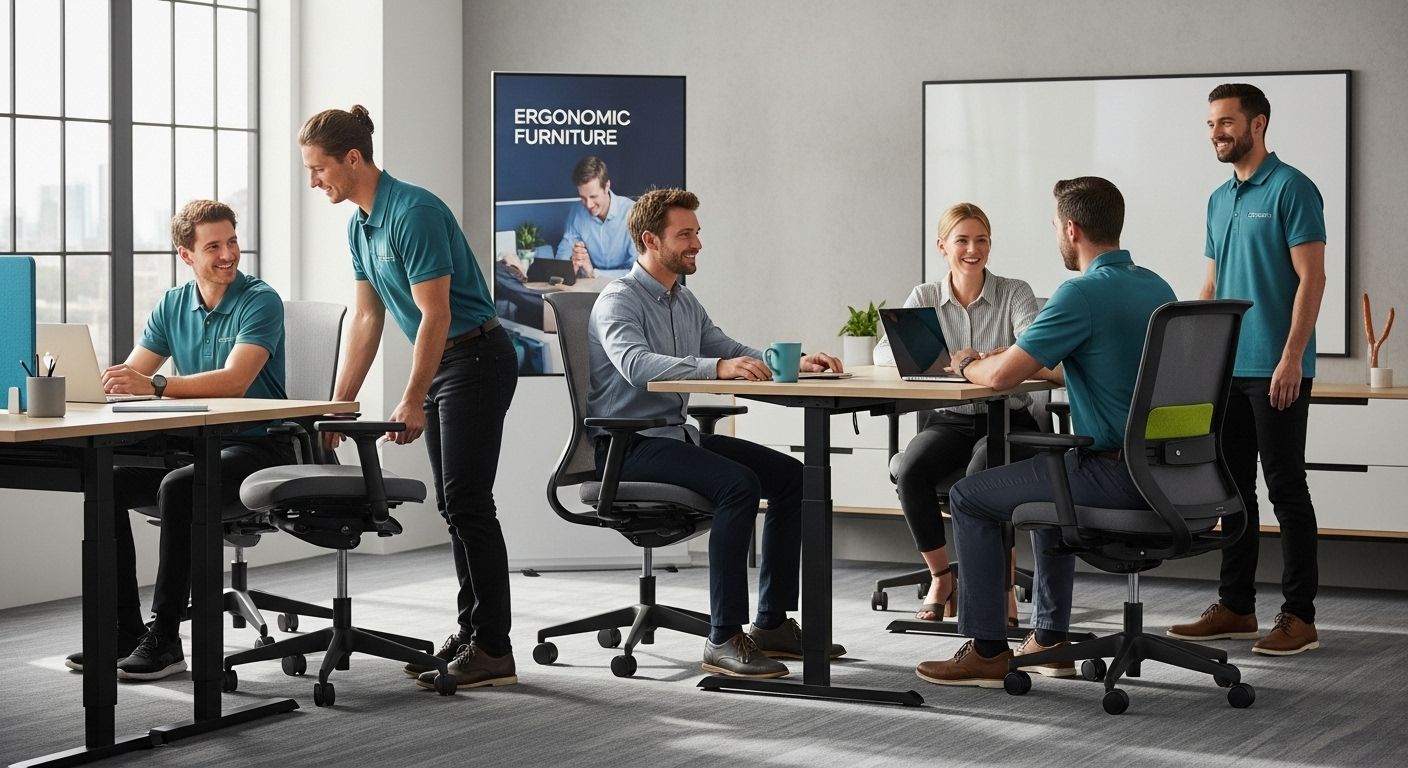What Is Ergonomic Furniture? Simple Guide for Businesses
Aug 14, 2025
What Is Ergonomic Furniture? Simple Guide for Businesses

Office chairs and workstations seem like an afterthought in most businesses, right. Think about this. Businesses that adopt ergonomic furniture can see productivity rise by up to 25 percent. Many still believe a standard desk and chair will do the trick. Turns out, the real value sits in the way ergonomic design protects employee health and actually saves money over time.
Table of Contents
- Understanding What Is Ergonomic Furniture
- Key Benefits Of Ergonomic Furniture For Workplaces
- Types Of Ergonomic Furniture For Different Businesses
- How To Choose Ergonomic Solutions In Southern Africa
Quick Summary
| Takeaway | Explanation |
|---|---|
| Ergonomic furniture enhances employee well-being | Prioritizing ergonomic design significantly reduces physical strain, promoting long-term health amidst sedentary work environments. |
| Improves productivity across workspaces | Comfortable and well-supported employees maintain higher concentration and efficiency, resulting in up to 25% productivity gains. |
| Investing in ergonomic solutions saves costs | Although initial expenses may be higher, reduced healthcare costs and employee sick leave lead to long-term savings. |
| Customized options for diverse industries | Different business environments require tailored ergonomic solutions—consider unique ergonomic needs for technical, creative, and corporate settings. |
| Align with local ergonomic standards | Ensuring compliance with local ergonomic regulations enhances workplace safety and supports employee health in Southern Africa. |
Understanding What Is Ergonomic Furniture
Ergonomic furniture represents a revolutionary approach to workplace design that prioritizes human physical well-being and performance. At its core, ergonomic furniture is scientifically engineered to adapt to the human body’s natural movements and support optimal posture, reducing physical strain and promoting long-term health.
The Science Behind Ergonomic Design
Ergonomic furniture is not merely about aesthetics or comfort but a comprehensive approach to workplace wellness. According to the Occupational Safety and Health Administration (OSHA), ergonomic furniture is specifically designed to minimize the risk of musculoskeletal disorders by creating workspaces that fit the user’s physiological needs. This means carefully crafting furniture that supports the body’s natural alignment, reduces unnecessary physical stress, and enables workers to maintain productivity without compromising their physical health.
The fundamental principle of ergonomic design involves understanding human biomechanics. Designers analyze how people move, sit, and interact with their workspace, then create furniture that supports these natural movements. An ergonomic chair, for instance, isn’t just a seat but a carefully engineered support system that adjusts to individual body types, provides lumbar support, and allows for dynamic sitting positions.
Key Components of Ergonomic Furniture
Successful ergonomic furniture integrates multiple design elements to create a holistic workplace solution. Adjustability is a critical feature, allowing users to customize their workspace to their unique body dimensions and working style. This might include chairs with adjustable seat heights, armrests that move in multiple directions, and desks that can transition between sitting and standing positions.
Research from Cornell University’s Ergonomics Research Group highlights that truly effective ergonomic furniture goes beyond simple adjustments. It considers factors like weight distribution, pressure points, and the dynamic nature of human movement. For example, an ergonomic chair might feature a waterfall edge that reduces pressure on the back of the thighs, or a desk with a curved design that allows more natural arm positioning during typing.
Moreover, ergonomic furniture isn’t limited to chairs and desks. It encompasses a wide range of workplace accessories designed to support human performance. Keyboard trays that position hands at the optimal angle, monitor stands that reduce neck strain, and footrests that improve circulation are all part of a comprehensive ergonomic approach.
Below is a summary table outlining the key components of ergonomic furniture as described in the article. This table helps clarify the primary features and accessories that contribute to overall workplace ergonomics.
| Component / Feature | Purpose / Benefit |
|---|---|
| Adjustable chairs | Adapt to body types; support lumbar region |
| Adjustable height desks | Allow sitting/standing; personalise workstyle |
| Armrests (multi-direction) | Customise arm support; reduce shoulder strain |
| Waterfall seat edges | Reduce thigh pressure; support healthy circulation |
| Keyboard trays | Optimise hand/wrist position; prevent repetitive injury |
| Monitor stands | Reduce neck strain; improve viewing comfort |
| Footrests | Encourage better circulation; promote good posture |
By understanding and implementing ergonomic furniture principles, businesses can create workspaces that not only look professional but actively contribute to employee health, comfort, and productivity. It represents an investment in human capital that goes far beyond traditional furniture selection.
Key Benefits of Ergonomic Furniture for Workplaces
Ergonomic furniture offers substantial advantages for businesses seeking to enhance workplace productivity, employee health, and overall organizational performance. By strategically investing in furniture designed to support human physiology, companies can unlock significant benefits that extend far beyond traditional workplace design.
Improving Employee Health and Reducing Physical Strain
According to a 2021 review in the Journal of Occupational Health, ergonomic interventions are directly associated with reduced musculoskeletal pain and fatigue. Employees who use ergonomically designed furniture experience significantly lower risks of developing chronic workplace-related health issues. These furniture solutions help prevent repetitive strain injuries, reduce back and neck pain, and minimize the long-term physical stress associated with sedentary work environments.
Ergonomic chairs with proper lumbar support, adjustable height desks, and carefully designed workstations can dramatically decrease the likelihood of developing conditions like carpal tunnel syndrome, chronic back pain, and other repetitive stress injuries. By prioritizing employee physical well-being, businesses can create a healthier, more sustainable work environment that supports long-term employee wellness.
Enhancing Workplace Productivity and Performance
Beyond health benefits, ergonomic furniture directly impacts workplace productivity. When employees are comfortable and physically supported, they can maintain higher levels of concentration and work efficiency. Research from the International Ergonomics Association indicates that well-designed workspaces can increase productivity by up to 25% through reduced physical discomfort and improved work posture.
Adjustable furniture allows employees to customize their workspace, creating personalized environments that support individual working styles. Standing desks, for instance, enable workers to alternate between sitting and standing, promoting better blood circulation and maintaining higher energy levels throughout the workday. These adaptable solutions demonstrate a company’s commitment to employee comfort and performance.
Long-Term Cost Savings and Organizational Benefits
Investing in ergonomic furniture represents a strategic financial decision for businesses. While the initial investment might seem higher compared to standard office furniture, the long-term benefits significantly outweigh the costs. Reduced employee sick leave, lower healthcare expenses, and decreased workplace injury claims contribute to substantial financial savings.

Moreover, ergonomic furniture signals an organization’s commitment to employee well-being. This approach can improve employee retention, attract top talent, and create a positive workplace culture that values employee health and comfort. Companies that prioritize ergonomic design demonstrate forward-thinking management and a genuine investment in their most valuable resource: their people.
By understanding and implementing ergonomic furniture solutions, businesses can transform their workspaces from mere functional areas to dynamic, health-supporting environments that promote employee wellness, productivity, and organizational success.
Types of Ergonomic Furniture for Different Businesses
Ergonomic furniture is not a one-size-fits-all solution but a nuanced approach to workplace design that varies significantly across different business environments. Understanding the specific ergonomic needs of various industries and workplace settings is crucial for selecting the most appropriate furniture solutions.
Ergonomic Furniture for Corporate Offices
Corporate environments demand sophisticated ergonomic solutions that support extended periods of desk-based work. According to the University of Washington’s Environmental Health & Safety department, key ergonomic furniture for corporate settings includes adjustable height desks, ergonomic chairs with lumbar support, and specialized accessories like keyboard trays and monitor stands.
Executive chairs with advanced adjustability features become critical in corporate settings. These chairs typically offer multiple adjustment points including seat height, armrest positioning, backrest tension, and seat depth. Sit-stand desks are particularly valuable in corporate environments, allowing employees to alternate between sitting and standing positions, which promotes better circulation and reduces the health risks associated with prolonged sedentary work.
Specialized Ergonomic Solutions for Technical and Creative Workspaces
Research from the University of North Carolina’s Environment, Health and Safety division highlights the unique ergonomic requirements for technical and creative workspaces. Graphic designers, software developers, and other professionals with specialized computing needs require tailored ergonomic furniture that supports complex technological setups.
Multi-monitor mounting systems, adjustable drafting chairs, and workstations with extensive cable management become essential. Ergonomic furniture in these environments must accommodate specialized equipment while maintaining user comfort. For instance, graphic designers might benefit from chairs with enhanced mobility and drafting height capabilities, while software developers might require wider desks with multiple levels to support complex computing environments.
Industry-Specific Ergonomic Furniture Considerations
Different industries present unique ergonomic challenges that require specialized furniture solutions. Manufacturing environments might prioritize anti-fatigue mats and industrial-grade chairs with robust support mechanisms. Healthcare settings demand furniture that facilitates quick movement and easy sanitization, such as mobile workstations with adjustable heights and antimicrobial surfaces.
Educational institutions require flexible furniture that can adapt to various learning configurations. Modular desks, stackable chairs, and collaborative workstations that can be quickly reconfigured represent ergonomic solutions tailored to dynamic educational environments. Hospitality and customer service sectors might focus on ergonomic solutions for reception areas and workstations that support extended periods of computer use and customer interaction.
The following comparison table highlights how different types of ergonomic furniture cater to the needs of various business environments, as discussed in the article. This overview can help businesses quickly identify which solutions best match their workspace requirements.
| Business Environment | Key Ergonomic Furniture/Features | Unique Needs/Considerations |
|---|---|---|
| Corporate Offices | Adjustable height desks, ergonomic chairs, accessories | Extended desk work; advanced adjustability |
| Technical/Creative Workspaces | Multi-monitor mounts, drafting chairs, cable management | Accommodate specialised equipment; enhanced mobility |
| Manufacturing | Anti-fatigue mats, robust industrial chairs | High durability; support for standing or movement |
| Healthcare | Mobile workstations, adjustable/mobile chairs | Easy sanitisation; quick movement; antimicrobial surfaces |
| Educational Institutions | Modular desks, stackable chairs, collaborative stations | Flexible, reconfigurable layout for dynamic environments |
| Hospitality/Customer Service | Ergonomic reception stations, comfortable chairs | Support for long computer use; customer interaction |
Learn more about our specialized ergonomic furniture solutions that cater to diverse business needs. By recognizing that each workplace has unique ergonomic requirements, businesses can create environments that not only support employee health but also enhance overall productivity and workplace satisfaction. The key lies in understanding the specific demands of each industry and selecting ergonomic furniture that addresses those precise needs.
How to Choose Ergonomic Solutions in Southern Africa
Selecting appropriate ergonomic furniture in the Southern African business landscape requires a strategic approach that considers local workplace regulations, diverse working environments, and specific regional ergonomic challenges. Understanding the nuanced requirements of businesses across South Africa demands a comprehensive evaluation of multiple factors to ensure optimal employee comfort and productivity.
Understanding Local Ergonomic Standards and Regulations
According to research on South African workplace design, businesses must align their ergonomic furniture choices with the Occupational Health and Safety Act’s Ergonomics Regulations. These standards emphasize the importance of designing workspaces that minimize physical strain and support employee well-being. Companies need to consider anthropometric variations among Southern African workforce demographics, ensuring furniture solutions accommodate different body types and working styles.
The International Organization for Standardization’s ISO 9241 standard provides critical guidelines for ergonomic design, offering comprehensive frameworks for evaluating human-system interactions. This standard helps businesses assess furniture functionality, adjustability, and overall workplace comfort. When selecting ergonomic solutions, organizations should prioritize products that offer multiple adjustment points, supporting diverse employee needs across various industries.
Evaluating Ergonomic Furniture for Local Work Environments
Choosing ergonomic furniture in Southern Africa requires careful consideration of regional work environments. Manufacturing sectors, technology companies, educational institutions, and service industries each present unique ergonomic challenges. Businesses must evaluate furniture solutions that provide flexibility, durability, and adaptability to local working conditions.
According to ISO 6385 international ergonomic standards, workplace design should prioritize human well-being while maintaining system performance. This means selecting furniture that not only looks professional but also supports long-term employee health. Key considerations include chair adjustability, desk height configurations, and accessories that promote proper posture and reduce physical strain.
Practical Considerations for Southern African Businesses
When selecting ergonomic furniture, Southern African businesses should consider several practical factors. Budget constraints, local manufacturing capabilities, and environmental conditions play significant roles in decision-making. Furniture must withstand diverse climate conditions, from humid coastal regions to arid inland areas, while maintaining structural integrity and comfort.
Check out our expert recommendations for ergonomic office solutions that are specifically designed for Southern African workplaces. Businesses should look for furniture with robust warranty options, local support networks, and demonstrable performance in regional work environments. Consider factors like material quality, ease of maintenance, and compatibility with existing office infrastructure.
Successful ergonomic furniture selection goes beyond aesthetic appeal. It requires a holistic approach that balances employee health, workplace productivity, and organizational budget constraints. By understanding local standards, evaluating specific workplace needs, and prioritizing adaptable design, Southern African businesses can create work environments that support employee well-being and organizational success.

Frequently Asked Questions
What is ergonomic furniture?
Ergonomic furniture is specially designed to support human physical well-being and performance, adapting to the body’s natural movements to reduce strain and promote long-term health.
What are the key benefits of using ergonomic furniture in the workplace?
The main benefits include improved employee health by reducing the risk of musculoskeletal disorders, enhanced workplace productivity, and long-term cost savings through decreased healthcare expenses and sick leave.
How does ergonomic furniture improve workplace productivity?
Ergonomic furniture enhances comfort and support, enabling employees to maintain better posture and focus, which can lead to productivity increases of up to 25% in many cases.
What should businesses consider when choosing ergonomic furniture?
Businesses should consider local ergonomic standards, the specific needs of their workforce, the adjustability of furniture, and how well the furniture supports diverse working styles and physical requirements.
Transform Your Workspace With Real Ergonomic Solutions for South African Businesses
Are you tired of seeing employees struggle with back pain, poor posture or endless discomfort at their desks? This article showed how traditional office setups fall short and why real ergonomic furniture is a game-changer for workplace health and productivity. Give your team the support they need with tailor-made office solutions that reduce physical strain, cut sick days and unlock up to 25 percent more output each day.

Experience the Office Stock difference. Browse our site at Office Stock to explore ergonomic chairs, height-adjustable desks, and accessories built for comfort. If you want expert, practical advice for your unique space, contact our support team today. Invest in your people now to create a healthier, more productive office.
